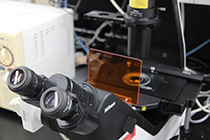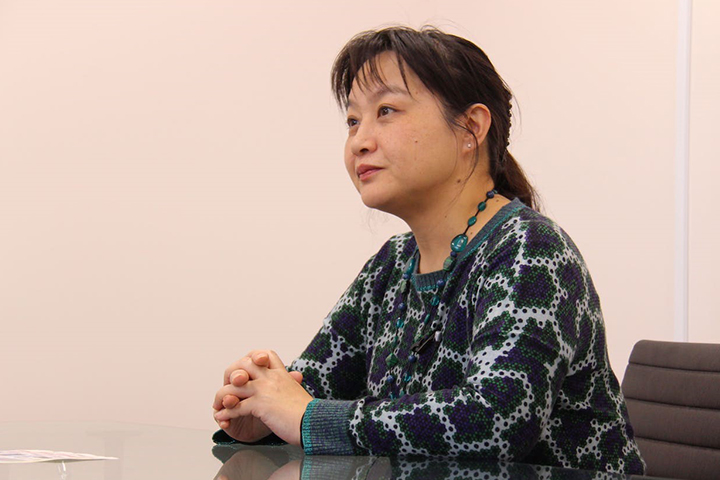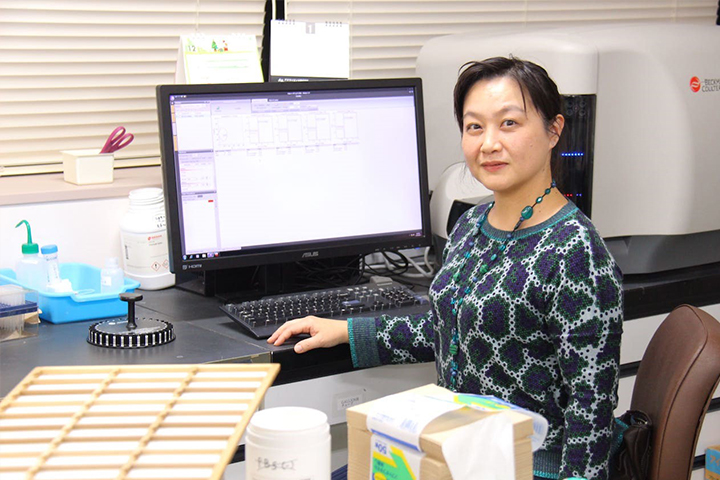TSUKUBA FUTURE
#115 Driven to Provide Care That No One Else Can
Assistant Professor OKIYAMA Naoko, Faculty of Medicine

Dermatologists will sometimes diagnose a skin condition on the spot after only glancing at the affected area. This may seem a bit concerning, but appearance is actually critical to making a dermatological diagnosis. In recent years, however, research has shown that the same diseases can manifest differently in different patients. Prof. OKIYAMA is working from the approaches of both a clinician and a researcher to deliver more effective treatments by linking results of experience-based visual examination to results of pathological examination.

One of the main things that tests the abilities of a dermatologist is visual examination, or diagnosis of conditions based on the appearance of the affected area. This alone is not enough to make a definitive diagnosis, but building sufficient experience to make assessments from appearance is a shortcut to making accurate diagnoses. However, skin abnormalities are not always caused by the skin itself. For example, in atopic dermatitis, skin symptoms appear as an allergic reaction when certain foreign substances trigger an overactive immune response. Immune function is a systemic issue, and thus eliminating skin symptoms does not treat the root cause of the condition. This illustrates why dermatologists need to know about not only skin conditions but also all the various conditions that can cause skin symptoms.
Prof. OKIYAMA's subspecialty in dermatology is connective tissue disease, which is a type of autoimmune disorder. Many patients first visit a dermatologist because of the skin symptoms, but it must be treated as a systemic disease once diagnosed. Dermatomyositis is one type of connective tissue disease. It has several subtypes classified by symptoms, and a specialist can differentiate between subtypes by visual examination. However, at one time it was unclear what exactly causes these differences, and simply observing them was not very useful for treatment selection.
To explore this topic, Prof. OKIYAMA collaborated with several hospitals to collect data on visual examination and skin tissue pathology results of patients with dermatomyositis. She then checked the results of each of them against one another over a period of several years. Through this work, she found that differences in the autoantibodies that cause dermatomyositis were what produced the differences in skin symptoms. Although several types of autoantibodies involved in dermatomyositis had been identified in recent years, and many physicians had noted differences in appearance in their clinical experience, Prof. OKIYAMA was the first in the world to establish objective evidence for these relationships. This could allow for selection of optimal treatment regimens for individual patients, which may improve prognoses.

She may forget the names of the patients she has seen in the past, but she remembers their skin lesions. This accumulation of experience is what makes an excellent dermatologist.
Connective tissue disease is a general term for diseases in which the immune system acts abnormally against a person's own body and causes inflammation in various organs. Rheumatoid arthritis is well known, but all other connective tissue diseases affect very few people and are designated as intractable diseases by the Japanese government. This means that they are severe, rare diseases for which no treatments have been established. Because they are systemic diseases, symptoms can appear anywhere in the body. Even with dermatomyositis, certain types can cause fatal lung disease in patients with mild skin symptoms. Physicians commonly misdiagnose or struggle to diagnose the condition by looking just at those rare symptoms, and a high level of expertise is required. Although connective tissue disease is rarely cured completely, patients can maintain their ability to perform daily activities without impairment if the condition is diagnosed early and good treatment is provided. This is one of Prof. OKIYAMA's goals when treating patients. However, she is also putting great effort into research to develop pinpointed treatments for various autoimmune disorders based on questions that arise in her clinical work.
Dermatology is perceived to be one of the less glamorous fields of medicine. Many medical students are put off by the appearance or smell of skin conditions, but Prof. OKIYAMA chose to pursue dermatology nonetheless because during a medical school practicum, she witnessed a dermatology professor correctly diagnose a patient with just a moment's glance and no testing after physicians of various other specialties had all failed to make a diagnosis. That diagnosis explained all the patient's various symptoms up to that point. Prof. OKIYAMA says that by building up her training, she would be able to deliver care no one else could provide. She wanted to become a physician whom patients would be glad they had met.
Thanks to advances in diagnostic technology, it is now not uncommon for diseases to be diagnosed by test results. Research on diagnosing diseases by imaging using artificial intelligence (AI) rather than visual examination is also progressing. Indeed, some studies have shown that AI can provide an accurate diagnosis more quickly for diseases that exhibit distinctive shapes and features, such as skin cancer. However, AI is not yet fully capable of diagnosing conditions in which symptoms manifest differently in different parts of the body, or when itchiness causes scratching that alters the appearance of the affected area, such as connective tissue disease and atopic dermatitis. The skin forms the body's outermost layer, and is our largest immune organ, protecting us from attack by external invaders. For this reason alone, it is subject to a wide range of diseases. Prof. OKIYAMA continues to develop her abilities by seeing many patients, making accurate diagnoses via both visual and pathological examination, and storing that information in her memory. This is where she finds her sense of value and pride as a dermatologist.

Prof. OKIYAMA has recently started working in the outpatient Allergology Department as well. The patients she sees as a clinician generate topics for her research.
Article by Science Communicator at the Office of Public Relations


